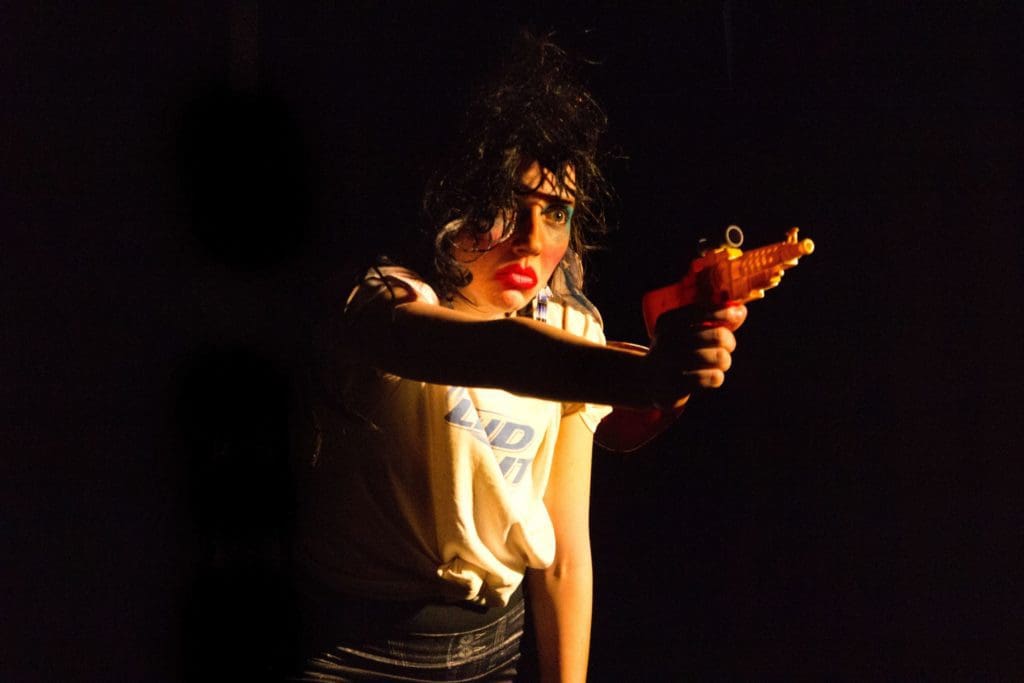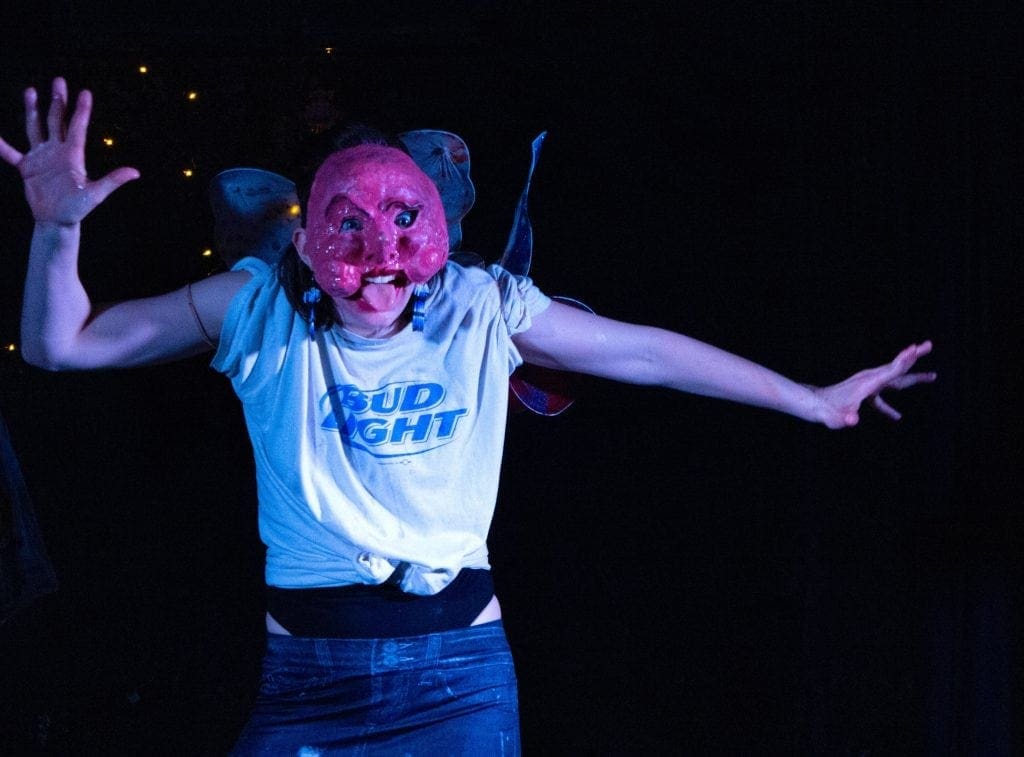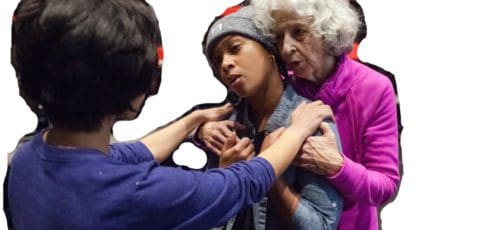Alex Tatarsky’s Americana Psychobabble: The First in a Tryptich on America’s Political Tragicomedy
Alexandra Tatarsky is an absurdist performer hailing from New York City who aims to present the current state of affairs in the United States through her mixture of performance art, theater, and clown. She studied with mask maker Stanley Sherman and attended the Pig Iron School in Philadelphia. She performs on stages, in galleries, museums, bars, and living rooms, sometimes as a mound of dirt, and once in an all-too-convincingly stunt as Andy Kaufman’s daughter. She also teaches at the School of Making and Thinking (Abrons Art Center) on Holy Fools, and at the School of Authentic Journalism in Mexico City on performance and community organizing. “I am obsessed with how a performance teaches an audience how to engage with it, and how a work can be fully alive to the particular room it’s in.” Americana Psychobabble is “an attempt to both exorcise and exercise our demons,” an examination of America’s underlying divisive hatred, feelings of abandonment, already-present absurdity, and penchant for ketchup. The show investigates the “empty trashy language careening between somewhat cogent critique and incomprehensible garble seemed to speak to the demonic complexity of the American spirit, and the ugliness that undergirds a razzle-dazzle surface.” The show is a part of the Fringe Festival as the first in what will hopefully become a triptych of performances, the second of which she began devising during the 2017 Camp Fringe. We had a chat with Alex to explore the drive behind this new work, and the path that led her to become an absurdist comic.
FringeArts: Where did you grow up, and how did you begin making art?
Alex Tatarsky: I was born and bred in New York City and was apparently singing songs in made-up languages in my stroller before I could walk, like most kids. But the first performance piece I remember was dressing up as a “butterfly-doggie” and walking around the East Village like that when I was three. So I think it’s fair to say I’ve always been interested in absurdist character work and the rich, uncomfortable spaces between categories. Venerable Philly poet CA Conrad points out that we all made art as kids and then some of us—due to resources, encouragement, delusion, devotion, or compulsion—kept making art and some of us stopped. But we all have that kid artist in us and can access it if we choose to.
 As a kid I danced with the magical Lisa Pilato for many years in a church basement by the West Side highway, and played a lot of street ball—both of which contributed considerably to my later development as a performer. But my main performance education for a long time mostly consisted of hanging out in parks and watching street performers like Master Lee chop a cucumber on an audience member’s dick, or Tic & Tac the acrobatic twins gather a huge crowd with some dancing but mostly jokes making fun of each other and the audience. Along with street preachers, panhandlers, drag queens, and anybody else vigorously monologue-ing on the street, these were my performance idols. I went on to study Russian literature and spent a few years thinking about and translating Russian Jewish poetry—whose concerns around the poet/prophet/lunatic are perhaps not unrelated—and when I got back to New York I began studying commedia with master mask maker Stanley Sherman. Eventually I decided it was time to go to proper clown school and ended up in Philly to train with Pig Iron who had blown me away when another clown guru, the amazing Ed Malone, took me to see their Twelfth Night in New York and Dito’s Iazzi so delighted me that I cried. But most importantly, I love to go out dancing and I credit the club as my main influence and form of movement-based research.
As a kid I danced with the magical Lisa Pilato for many years in a church basement by the West Side highway, and played a lot of street ball—both of which contributed considerably to my later development as a performer. But my main performance education for a long time mostly consisted of hanging out in parks and watching street performers like Master Lee chop a cucumber on an audience member’s dick, or Tic & Tac the acrobatic twins gather a huge crowd with some dancing but mostly jokes making fun of each other and the audience. Along with street preachers, panhandlers, drag queens, and anybody else vigorously monologue-ing on the street, these were my performance idols. I went on to study Russian literature and spent a few years thinking about and translating Russian Jewish poetry—whose concerns around the poet/prophet/lunatic are perhaps not unrelated—and when I got back to New York I began studying commedia with master mask maker Stanley Sherman. Eventually I decided it was time to go to proper clown school and ended up in Philly to train with Pig Iron who had blown me away when another clown guru, the amazing Ed Malone, took me to see their Twelfth Night in New York and Dito’s Iazzi so delighted me that I cried. But most importantly, I love to go out dancing and I credit the club as my main influence and form of movement-based research.
FringeArts: Who are some artists that you look up to?
Alex Tatarsky: Miguel Gutierrez, Abner Jay, Trajal Harrell, the Kuchar Brothers, my uncle Miles, Richard Pryor, Dario Fo, Lenny Bruce, Ishmael Houston-Jones, Frank Wedekind, Cecilia Vicuña, Gershom Scholem, Aventura, Andy Kaufman, Edouard Glissant, Lucy Hopkins, Stuart Hall, Marguerite Hemmings, Grace Lee Boggs, Charlie Chaplin, Cam’ron… all extravagant thinkers pushing at the edges of their disciplines and challenging us to imagine new worlds and ways of being.
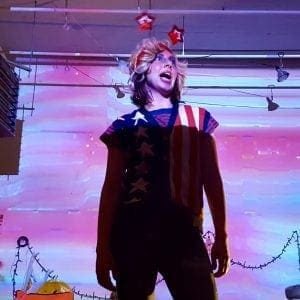 FringeArts: What is your process like when putting a show together?
FringeArts: What is your process like when putting a show together?
Alex Tatarsky: Inspiration for me generally comes from deadlines. I am constantly walking around singing and babbling to myself but this babbling only finds its form when it’s forced to. One time I wrote a really long song that I have yet to perform anywhere outside my bedroom that’s just a guy going more and more crazy and not actually making anything because he is so inspired by everything. “I find that brick . . . so inspiring! That Dorito bag is so . . . inspiring! What an inspiring . . . stump! I’m just so inspired by that pothole!”
A show never feels finished, it’s always being re-worked for different contexts, but the frame of a particular space helps define what it is. I am obsessed with how a performance teaches an audience how to engage with it, and how a work can be fully alive to the particular room it’s in. Ahem, as for my particular process when I am making a solo piece, it involves a lot of excited mania and anxious desperation. I continue to have the sense that I have no idea what I am doing and basically torment myself with self-doubt until I start laughing or crying which is almost the same thing—a laugh is just a backwards scream, as I always say HAA-AAH, or rather, AH-HA!—and then from this abyss the process is drinking coffee and writing and dancing. Reading a lot. Trying to figure out the form a feeling should take. Seeking out a state or character or mask that liberates me to be big and loud; otherwise, believe it or not, I can be very shy—and confused to the point of paralysis by the ridiculous idea of “being yourself” as if we only have one self to be. I improvise a lot and take baths and think and walk around crowded places where nobody will notice me ranting and try to figure out what questions and images keep burbling up and how they might be shaped into a journey of some sort for an audience. In this sense I feel inspired by Eisenstein’s montage and the associative logics of poems and dancing. What can be put side by side that is surprising and maybe jarring or unsettling but makes intuitive sense and welcomes the audience into a sort of fever dream? I am also very inspired by dollar stores. And edible weeds. Chickweed, for instance, grows wild all over Philadelphia and you can eat it.
FringeArts: Where did Americana Psychobabble come from?
Alex Tatarsky: TV, internet, and casual conversation. I wanted to make a piece that was not explicitly situated in a particular political stance but occupied a more slippery place. I tried to give myself permission to work in an anti-narrative vein and challenge a desire for arc and clarity. Instead, I was interested in different attempts to capturing a mood of hysteria, despair, desire, and ultimately fatigue, in order to move through these feelings and maybe come out the other side. The piece grew from an improvisation in response to a photograph, provided by the prophetic Quinn Bauriedel, of fingernails painted with the American flag, in all their red-white-and-blue shininess and desperate clutching. What came out was a sort of psychobabble: according to Wikipedia, “psychoanalysis” plus “babble” is “a form of speech that uses jargon, buzzwords, and esoteric language to create an impression of truth or plausibility.” This empty trashy language careening between somewhat cogent critique and incomprehensible garble seemed to speak to the demonic complexity of the American spirit and the ugliness that undergirds a razzle-dazzle surface. I began to think of the piece as a series of attempts to channel this spirit and exercise the demons.
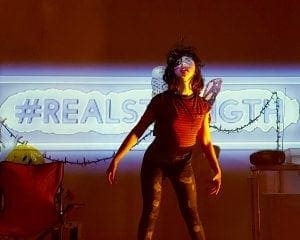 FringeArts: What inspired you to create this show, and what makes tragicomedy the best genre to perform here?
FringeArts: What inspired you to create this show, and what makes tragicomedy the best genre to perform here?
Alex Tatarsky: Gringos in Cancun in a Mexican restaurant without air-conditioning every night of the Republican National Convention. Also I had just had my heart broken. The vitriol on TV sounded to me like it was coming from a bunch of heartbroken people who felt afraid and betrayed and needed to channel their anger into something, apparently hate speech. And I was a recent clown school graduate watching the imminent election of a fool-king. The absurdity of the situation struck me as a tragicomedy and spurred a piece that both indulges in and questions the healing potential of laughter. I became interested in unpacking the nostalgic artifacts and empty cliches that comprise an Americana mythos, at once compelling and horrifying. What we are seeing now with the Cheetoh-in-charge is not so much a shocking break with the status quo, but rather the inevitable culmination of a country founded on genocide, slavery, and a romantic attachment to the rugged, gold-obsessed male. Americana Psychobabble is the first exploration in what I hope will be a triptych exploring Americana violence and nonsense, the second part being an ensemble work we have just begun devising, and the third part being running for office.
FringeArts: What was Camp Fringe like, and how did it influence your work?
Alex Tatarsky: Camp Fringe was such a treat! It is wonderful to occasionally feel like an artist and also a dignified human being. My favorite thing is having the time and space to explore, and the resources to pay my collaborators a living wage for their time, something that happens far too rarely in the theater-making world. Camp Fringe made this possible for one glorious week and we were able to begin devising part two of the Americana exploration as an ensemble—something that simply wouldn’t have been possible without this opportunity. And the lunch was delicious. As the daughter of Jewish shrinks, like me, Meryl Sands is very astute at understanding my brand of madness and has been just the most amazing and insightful friend, collaborator, outside eye, and dramaturge throughout this process!
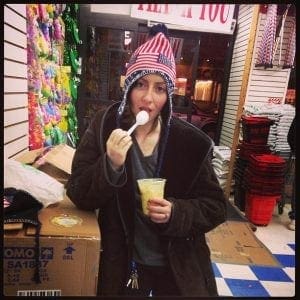 FringeArts: What’s your experience been like with the Philly arts community?
FringeArts: What’s your experience been like with the Philly arts community?
Alex Tatarsky: The Philly arts community is so fabulous in part because the cost of living is still cheap enough that artists can find the space and time to investigate and explore more deeply than in other urban centers where everyone’s soul has been sucked out trying to make rent. Let’s hope Philly stays affordable. There is an incredibly rich constellation of Philly artists, too many to name, working in dance, physical theater, and hybrid forms and there’s a real sense of community among performance-makers. I do sometimes wish there were more overlap between professionalized companies making work with extensive institutional support and scrappy outfits performing noisy freak shows in filthy basements. I think everyone could learn a thing or two from each other.
Americana Psychobabble
Alex Tatarsky
PWYW / 60 minutes
Berks Warehouse
1801 North Howard Street
September 16th at 10pm
September 17th at 8pm
September 21st at 8pm
September 22nd at 9pm
September 23rd at 10pm
—Isabella Siegel
Photos: Lyndia Kincaid (banner, first, second, fourth photos,) Rob Gallo (third and fifth photos, ) Liana Satenstein (last photo)

